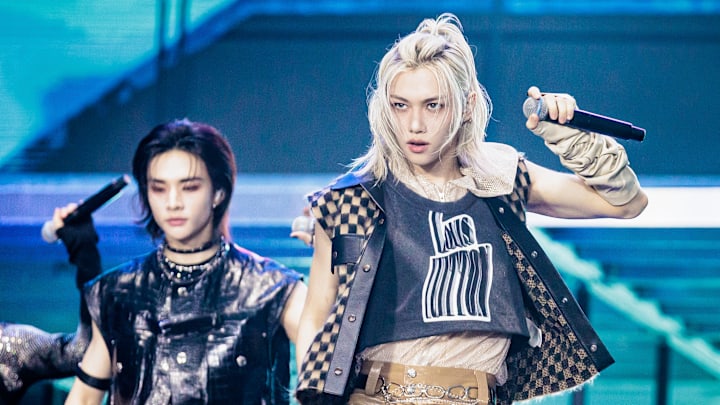From golden eggs reminiscent of Daenerys’s dragon eggs to icy blue eyes that evoke White Walkers, Stray Kids crafts a cinematic narrative in Giant that feels as legendary as a GOT saga. Their visuals further elevate this concept, featuring intricate thrones, medieval-inspired outfits, and a striking contrast between shadowy blacks and brilliant whites.
The throne itself, adorned with eight swords—a nod to the group’s eight members—and a compass symbol closely tied to their identity, becomes a powerful emblem of their unity and direction. This visual language carries over into HOP, their next stage, where the group incorporates a hip-hop aesthetic mixed with traditional Korean elements, showcasing once again their ability to blend modernity with cultural heritage elegantly.
Stray Kids(스트레이 키즈) "合 (HOP)"
— Stray Kids (@Stray_Kids) November 20, 2024
Stray Kids 𝗪𝗮𝗹𝗸𝗶𝗻 𝗢𝗻 𝗪𝗮𝘁𝗲𝗿 🎭
2024.12.13 FRI 2PM (KST) | 0AM (ET)
💦PRE-SAVE & PRE-ORDER "合 (HOP)" NOW!https://t.co/cV9tYAyUR7#StrayKids #스트레이키즈#合 #HOP#SKZHOP_HIPTAPE#WalkinOnWater#StrayKidsComeback… pic.twitter.com/uvBUd6ox7k
The Tower of God connection deepens this head-to-the-top narrative. Much like the anime’s protagonist, who faces an unrelenting ascent toward his goals, Stray Kids also navigate a journey fraught with challenges. Their contributions to Tower of God’s soundtrack, including the intense “TOP” and “SLUMP” for the anime’s first season, already showcased their ability to channel the anime’s core themes of ambition, resilience, and overcoming impossible odds. Now, with Giant, those same themes are carried forward, including the group’s latest tracks for the anime's second season, which further explore the emotional intensity and determination that define both the series and Stray Kids' artistry. These new songs amplify the bond between the group's journey and the anime's narrative of relentless pursuit and growth.
Reportedly, cruel comments about the members’ heights surfaced, mocking their shorter stature—Hyunjin, the tallest, stands just over 179 cm. Stray Kids, however, turned this into fuel for their artistry. Lines like “People think I’m big, but I’m small” and “do-re-mi-fa, King Giant” cleverly reclaim these remarks, transforming them into a triumphant declaration of dominance. Their defiance proves that true power isn’t measured in centimeters but in the magnitude of their impact and ambition.
Stray Kids takes the labels others impose and redefines them, owning their narrative. This clever defiance echoes a sentiment familiar to K-pop legends like BTS, who have long used their music to dismantle stereotypes and silence haters.
"GIANT" by @Stray_Kids debuts at #1 on the Worldwide iTunes Album Chart. pic.twitter.com/oWwrZh8LDW
— Pop Core (@TheePopCore) November 13, 2024
The fractured staircase featured on the Giant album cover vividly encapsulates this journey. A giant bootprint, as if crushing the steps under an immense weight, dominates the image. At the center of the destruction lies the Stray Kids logo, asserting their presence as the force breaking through barriers. The visual reinforces the narrative of struggle and triumph: every broken step is a testament to their resilience and determination to keep climbing, no matter the obstacles.
In Giant, the group’s lyrics soar alongside their ambition. Lines like “We go overseas, body becoming massive” underline their global reach and growing influence. The song embraces both their perceived "smallness" and the overwhelming magnitude of their dreams, showing that true power comes from within. The phrase “A sneeze is a typhoon” is a clever metaphor, reflecting their ability to create a storm of change with seemingly minimal effort. It’s a celebration of persistence, even in the face of doubt.
Stray Kids adds new dates all around the world for the DominATE world tour. pic.twitter.com/a24cGAxMsF
— About Music (@AboutMusicYT) November 18, 2024
This global impact extends far beyond their music. Stray Kids has already made waves internationally, including their contributions to the Deadpool and Wolverine soundtrack, demonstrating their growing cultural influence. Their ongoing world tour, which spans the Americas, Europe, and Latin America, further cements their position as K-pop giants breaking barriers on a global scale. The phrase “head to the top” encapsulates their artistic vision and ability to resonate with audiences worldwide, transcending language and cultural divides.
The head-to-the-top narrative has been a constant thread woven through their discography. From District 9 to God’s Menu, the group has continually explored themes of ambition, struggle, and triumph. With Giant, these ideas mature, reflecting their growth as artists and individuals. Bang Chan’s leadership plays a pivotal role in this journey, much like the protagonist of Tower of God, guiding the group through challenges with resilience and vision. His role as a steadfast leader mirrors the themes of unity and determination that define Giant.
Stray Kids
— Stray Kids Japan Official (@Stray_Kids_JP) September 29, 2024
KING GIANT#StrayKids#スキズ#KING_GIANT pic.twitter.com/Lnk8uiEf7U
The visuals complement this lyrical journey. The icy throne, reminiscent of the Iron Throne from Game of Thrones, represents their rise to power despite challenges. The stark contrast between their dark, regal outfits and the pure white aesthetic in other scenes symbolizes duality: the battle between light and dark, doubt and self-belief, vulnerability and strength. Stray Kids invites listeners to embrace this duality, recognizing that growth comes from both triumphs and trials.
Finally, the connection to their fandom, STAY, is undeniable. The themes in Giant reflect the shared journey between the group and their fans: a story of overcoming limitations and dreaming big. For STAYs, the idea of being "small but giant" mirrors their own experiences, making the song an anthem of empowerment and unity.
As part of a trilogy that began with ATE, followed by Giant, and will continue with HOP, Stray Kids crafts a layered narrative of ambition and self-expression. While Giant stands tall as a defiant statement of strength and resilience, it leaves us eagerly anticipating how HOP will expand on these themes. Will it delve further into reflections on identity, or will it uncover a new dimension of their artistic evolution? Whatever the case, Stray Kids continues to prove that being a "giant" isn’t about size but about the enormity of their dreams and the impact they leave behind.
